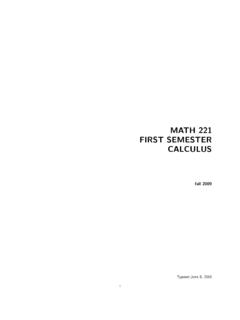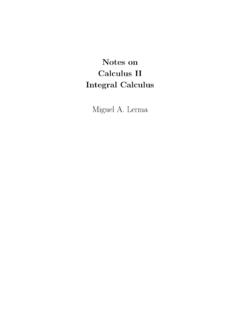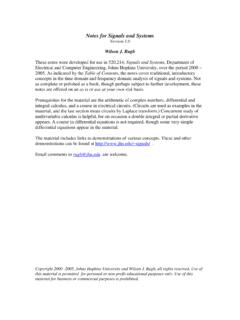Transcription of CHAPTER 14 Multiple Integrals 14.1 Double Integrals ...
1 Contents CHAPTER 14 Multiple Integrals Double Integrals Changing to Better Coordinates Triple Integrals Cylindrical and Spherical Coordinates CHAPTER 15 Vector Calculus Vector Fields Line Integrals Green's Theorem Surface Integrals The Divergence Theorem Stokes' Theorem and the Curl of F. CHAPTER 16 Mathematics after Calculus Linear Algebra Differential Equations Discrete Mathematics Study Guide For CHAPTER 1. Answers to Odd-Numbered Problems Index Table of Integrals C H A P T E R 14. Multiple Integrals Double Integrals 4. This CHAPTER shows how to integrate functions of two or more variables. First, a Double integral is defined as the limit of sums. Second, we find a fast way to compute it. The key idea is to replace a Double integral by two ordinary "single" Integrals . The Double integral f(x, y)dy dx starts with 1f(x, y)dy.
2 For each fixed x we integ- Sf rate with respect to y. The answer depends on x. Now integrate again, this time with respect to x. The limits of integration need care and attention! Frequently those limits on y and x are the hardest part. Why bother with sums and limits in the first place? Two reasons. There has to be a definition and a computation to fall back on, when the single Integrals are difficult or impossible. And also-this we emphasize- Multiple Integrals represent more than area and volume. Those words and the pictures that go with them are the easiest to understand. You can almost see the volume as a "sum of slices" or a " Double sum of thin sticks." The true applications are mostly to other things, but the central idea is always the same: Add up small pieces and take limits. We begin with the area of R and the volume of by Double Integrals .
3 A LIMIT OF SUMS. The graph of z =f(x, y) is a curved surface above the xy plane. At the point (x, y) in the plane, the height of the surface is z. (The surface is above the xy plane only when z is positive. Volumes below the plane come with minus signs, like areas below the x axis.) We begin by choosing a positive function-for example z = 1 + x2 + y2. The base of our solid is a region R in the xy plane. That region will be chopped into small rectangles (sides Ax and Ay). When R itself is the rectangle 0 d x < 1, 0 < y < 2, the small pieces fit perfectly. For a triangle or a circle, the rectangles miss part of R. But they do fit in the limit, and any region with a piecewise smooth boundary will be acceptable. Question What is the volume above R and below the graph of z =Ax, y)? Answer It is a Double integral-the integral of f(x, y) over R.
4 To reach it we begin with a sum, as suggested by Figure 14 Multiple Integrals area AA. Fig. Base R cut into small pieces AA. Solid V cut into thin sticks AV = z A A. For single Integrals , the interval [a, b] is divided into short pieces of length Ax. For Double Integrals , R is divided into small rectangles of area AA = (Ax)(Ay). Above the ith rectangle is a "thin stick" with small volume. That volume is the base area AA times the height above it-except that this height z =f(x, y) varies from point to point. Therefore we select a point (xi, y,) in the ith rectangle, and compute the volume from the height above that point: volume of one stick =f(xi, yi)AA volume of all sticks = 1f(xi, yi)AA. This is the crucial step for any integral-to see it as a sum of small pieces. Now take limits: Ax -+ 0 and Ay 0.
5 The height z =f(x, y) is nearly constant over -+. each rectangle. (We assume that f is a continuous function.) The sum approaches a limit, which depends only on the base R and the surface above it. The limit is the volume of the solid, and it is the Double integral of f(x, y) over R: J JR f(x, y) dA = lim A x -t 0. Ay+O. 1f(xi, yi)AA. To repeat: The limit is the same for all choices of the rectangles and the points (xi, yi). The rectangles will not fit exactly into R, if that base area is curved. The heights are not exact, if the surface z =f(x, y) is also curved. But the errors on the sides and top, where the pieces don't fit and the heights are wrong, approach zero. Those errors are the volume of the "icing" around the solid, which gets thinner as Ax -+ 0 and Ay -+ 0. A careful proof takes more space than we are willing to give.
6 But the properties of the integral need and deserve attention: 1. Linearity: jj(f + g)dA = jj f d~ + j j g dA. 2. Constant comes outside: jj cf(x, y)dA = c jj f(x, y)dA. 3. R splits into S and T(not overlapping): ]j f d~ = jj f d +~jj f d ~ . R S T. In 1 the volume under f + g has two parts. The "thin sticks" of height f + g split into thin sticks under f and under g. In 2 the whole volume is stretched upward by c. In 3 the volumes are side by side. As with single Integrals , these properties help in computations. By writing dA, we allow shapes other than rectangles. Polar coordinates have an extra factor r in dA = r dr do. By writing dx dy, we choose rectangular coordinates and prepare for the splitting that comes now. Double Integrals 523. SPLITTING A Double INTEGRAL INTO TWO SINGLE Integrals .
7 The Double integral JSf(x, y)dy dx will now be reduced to single Integrals in y and then x. (Or vice versa. Our first integral could equally well be ff(x, y)dx.) CHAPTER 8. described the same idea for solids of revolution. First came the area of a slice, which is a single integral. Then came a second integral to add up the slices. For solids formed by revolving a curve, all slices are circular disks-now we expect other shapes. Figure shows a slice of area A(x). It cuts through the solid at a fixed value of x. The cut starts at y = c on one side of R, and ends at y = d on the other side. This particular example goes from y = 0 to y = 2 (R is a rectangle). The area of a slice is the y integral of f(x, y). Remember that x is fixed and y goes from c to d: A(x) = area of slice = f(x, y)dy (the answer is a function of x).
8 EXAMPLE 1 A = (1 + x2 +y2)dy =[y + x2y+ - 2 2x2 8. y= 0 13 =O= 3. 2. This is the reverse of a partial derivative! The integral of x dy, with x constant, is x 2y. This "partial integral" is actually called an inner substituting the limits y = 2 and y = 0 and subtracting, we have the area A(x) = 2 + 2x 2 + 1. Now the outer integraladds slices to find the volume f A(x) dx. The answer is a number: 3. S8) 2 [ 2x 81' 2 8 16. volume = 2 + x2 + dx= 2x + ~ + 8x = 2+ - + 8- =o 3 = 3 3 3 3 3. z nelgnt f(x, y). 1-----7:. I. I. I. I. I. I. ~. I. I. I. I. fix. II I I I I. Iin I I I I. II 1\ I I I I. x x ix y Fig. A slice of V at a fixed x has area A(x) = ff(x, y)dy. To complete this example, check the volume when the x integral comes first: inner integral = (1 + x y2)dx =x + xy2 = +2. x=0 3 x=0 3. 16.]]
9 S4 1 y2 8 8. + y2 dy = y+ 1-y3]Y =2 = 8. outer integral - 3 3 3 Y=O 3 3 16. 3. The fact that Double Integrals can be split into single Integrals is Fubini's Theorem. 14A Iff(x, y) is continuous on the rectangle R, then Sf(x, y)dA = [ f(x, y)dy dx =d [b f(x, y)dx dy. (2). 524 14 Multiple Integrals The inner Integrals are the cross-sectional areas A(x) and a(y) of the slices. The outer Integrals add up the volumes A(x)dx and a(y)dy. Notice the reversing of limits. Normally the brackets in (2) are omitted. When the y integral is first, dy is written inside dx. The limits on y are inside too. I strongly recommend that you compute the inner integral on one line and the outer integral on a separate line. EXAMPLE 2 Find the volume below the plane z = x - 2y and above the base triangle R. The triangle R has sides on the x and y axes and the line x + y = 1.]
10 The strips in the y direction have varying lengths. (So do the strips in the x direction.) This is the main point of the example-the base is not a rectangle. The upper limit on the inner integral changes as x changes. The top of the triangle is at y = 1 - x. Figure shows the strips. The region should always be drawn (except for rectangles). Without a figure the limits are hard to find. A sketch of R makes it easy: y goes from c = 0 to d = 1 - x. Then x goes from a = 0 to b = 1. The inner integral has variable limits and the outer integral has constant limits: - X)(1 - ) 2. 2. inner: Y (x - 2y)dy= [xy y2 x -1+ 3x -2x y=0. 3 2 2= 33 22 11. outer: (- + 3x - 2x2)dx= - x + x 3. 31. x=o 2 o 2 3 6. The volume is negative. Most of the solid is below the xy plane. To check the answer - 6, do the x integral first: x goes from 0 to 1 - y.]















